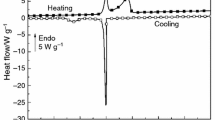Abstract
ELASTIN is insoluble in all reagents except those which break peptide bonds, and when wet the protein behaves as a typical rubber-like solid1. These characteristics, together with the swelling properties, are consistent with the view that elastin can be regarded as a cross-linked polymer gel containing long peptide chains randomly crumpled and held laterally at intervals by strong chemical bonds2. In an attempt to isolate small regions of the peptide network containing the cross-links, Thomas and Partridge3 degraded the protein by use of a succession of proteolytic enzymes followed by amino- and carboxy-peptidases. The product consisted of amino-acids and small peptides together with a fraction of higher molecular weight. This fraction was isolated and was found to be bright yellow in colour with the blue-white fluorescence characteristic of elastin fibres.
Similar content being viewed by others
References
Hoeve, C. A. J., and Flory, P. J., J. Amer. Chem. Soc., 80, 6523 (1958).
Partridge, S. M., Advances in Protein Chemistry, 17, 227 (Academic Press, New York, 1962).
Thomas, J., and Partridge, S. M., First Intern. Cong. Food Sci. and Tech., Proc. (in the press).
Author information
Authors and Affiliations
Rights and permissions
About this article
Cite this article
PARTRIDGE, S., ELSDEN, D. & THOMAS, J. Constitution of the Cross-linkages in Elastin. Nature 197, 1297–1298 (1963). https://doi.org/10.1038/1971297a0
Issue Date:
DOI: https://doi.org/10.1038/1971297a0
- Springer Nature Limited
This article is cited by
-
LC–MS/MS analysis of desmosine and isodesmosine in skipjack tuna “Katsuo” elastin
European Food Research and Technology (2023)
-
Heterocycles of Natural Origin as Non-Toxic Reagents for Cross-Linking of Proteins and Polysaccharides
Chemistry of Heterocyclic Compounds (2017)
-
Electron Transfer and Collision Induced Dissociation of Non-Derivatized and Derivatized Desmosine and Isodesmosine
Journal of the American Society for Mass Spectrometry (2013)
-
The chemistry of natural enzyme-induced cross-links of proteins
Amino Acids (1991)





